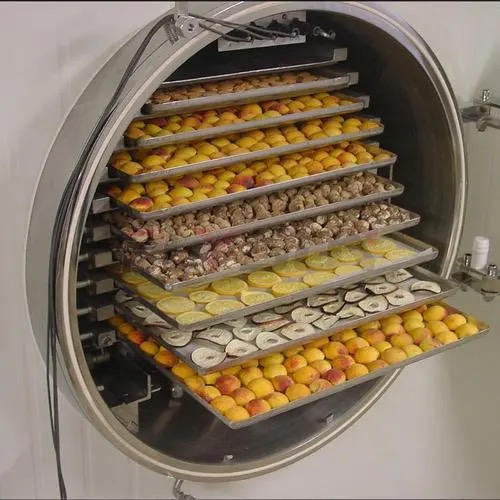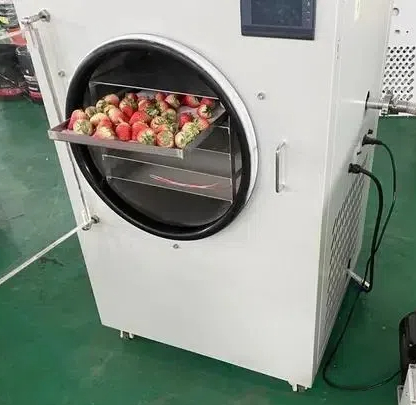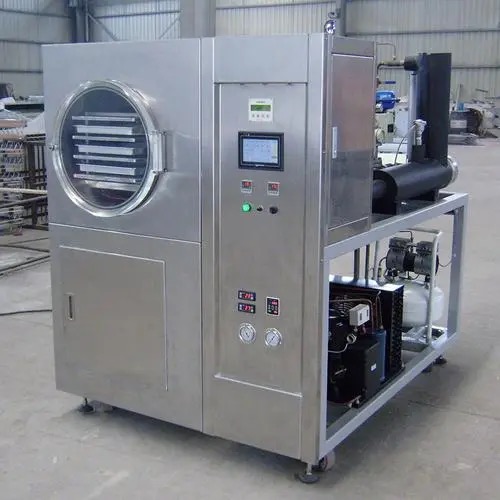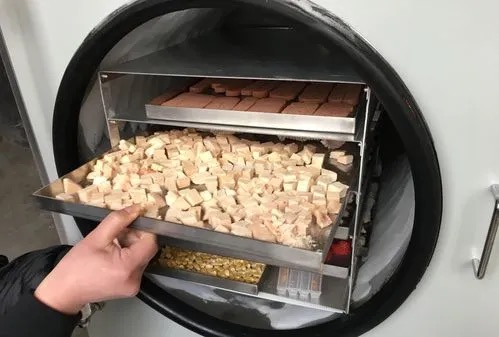
Content Menu
● Introduction to Freeze Drying Technology
● Understanding Home Freeze Dryer Options
>> 1. Small Home Freeze Dryer
>> 2. Medium Home Freeze Dryer
>> 3. Large Home Freeze Dryer
● Factors Affecting Freeze Dried Food Machine Cost
>> 1. Size and Capacity
>> 2. Pump Type
>> 3. Additional Features
>> 4. Brand and Quality
● Hidden Costs to Consider
>> 1. Energy Consumption
>> 2. Maintenance and Repairs
>> 3. Packaging Materials
● Comparing Freeze Drying to Other Preservation Methods
>> 1. Freeze Drying vs. Dehydration
>> 2. Freeze Drying vs. Canning
>> 3. Freeze Drying vs. Freezing
● Is a Home Freeze Dryer Worth the Investment?
>> 1. Frequency of Use
>> 2. Types of Food Preserved
>> 3. Emergency Preparedness
>> 4. Dietary Preferences
● Tips for Maximizing Your Freeze Dryer Investment
● Conclusion
● Frequently Asked Questions
>> 1. How long do freeze-dried foods last?
>> 2. Can all foods be freeze-dried?
>> 3. How does the cost of home freeze-dried food compare to store-bought freeze-dried products?
>> 4. Are there any alternatives to buying a home freeze dryer?
>> 5. How much electricity does a home freeze dryer use?
Introduction to Freeze Drying Technology
Freeze drying, also known as lyophilization, is a sophisticated food preservation method that has gained significant popularity in recent years. This process involves freezing food and then removing the water content through sublimation, resulting in lightweight, shelf-stable products that retain their original flavor, texture, and nutritional value. As more people become interested in long-term food storage and emergency preparedness, the demand for home freeze dryers has surged. However, one of the most common questions potential buyers face is the freeze dried food machine cost and whether it's a worthwhile investment.
Understanding Home Freeze Dryer Options
When considering a home freeze dryer, it's essential to understand the available options in the market. Currently, Harvest Right is the leading manufacturer of home freeze dryers, offering various models to suit different needs and budgets. Let's explore the different sizes and their corresponding freeze dried food machine costs:
1. Small Home Freeze Dryer
The small home freeze dryer is ideal for individuals or small families. It can process about 4-7 pounds of fresh food per batch, which translates to 1-1.5 gallons of food. The freeze dried food machine cost for this model typically ranges from $2,195 to $2,695, depending on the finish and accessories included.
2. Medium Home Freeze Dryer
For larger families or those who want to process more food at once, the medium-sized freeze dryer is a popular choice. It can handle 7-10 pounds of fresh food per batch, or 1.5-2.5 gallons. The freeze dried food machine cost for this model usually falls between $2,695 and $3,195.
3. Large Home Freeze Dryer
The large home freeze dryer is designed for serious food preservers or small businesses. It can process 12-16 pounds of fresh food per batch, equivalent to 3.5 gallons. The freeze dried food machine cost for this model ranges from $3,395 to $3,895.

Factors Affecting Freeze Dried Food Machine Cost
Several factors contribute to the overall cost of a freeze dryer:
1. Size and Capacity
As mentioned earlier, larger machines with higher capacities come with a higher price tag. Consider your needs carefully to choose the right size for your household.
2. Pump Type
Freeze dryers typically come with either an oil pump or an oil-free pump. Oil pumps are less expensive but require regular maintenance, while oil-free pumps are more costly upfront but require less maintenance over time.
3. Additional Features
Some models come with extra features like touchscreen controls, pre-programmed settings, or advanced monitoring systems. These features can increase the freeze dried food machine cost but may provide added convenience.
4. Brand and Quality
While Harvest Right is currently the primary manufacturer of home freeze dryers, other brands may enter the market in the future. The brand reputation and quality of construction can impact the price.
Hidden Costs to Consider
When evaluating the freeze dried food machine cost, it's crucial to factor in additional expenses that may not be immediately apparent:
1. Energy Consumption
Freeze dryers consume a significant amount of electricity. On average, a home freeze dryer uses about 1-1.5 kWh of electricity per hour of operation. Depending on your local electricity rates, this can add up to $1-$3 per batch in energy costs.
2. Maintenance and Repairs
Regular maintenance is essential to keep your freeze dryer in good working condition. This includes changing the oil in oil pumps, replacing filters, and occasionally replacing gaskets or other parts. Budget for these ongoing expenses when considering the long-term freeze dried food machine cost.
3. Packaging Materials
To properly store freeze-dried foods, you'll need to invest in mylar bags, oxygen absorbers, and a heat sealer. While not exorbitant, these costs can add up over time.
Comparing Freeze Drying to Other Preservation Methods
To truly understand the value proposition of a home freeze dryer, it's helpful to compare it to other food preservation methods:
1. Freeze Drying vs. Dehydration
While both methods remove moisture from food, freeze drying is superior in terms of preserving nutritional value, flavor, and texture. However, the freeze dried food machine cost is significantly higher than that of a food dehydrator.
2. Freeze Drying vs. Canning
Canning is a more affordable preservation method, but it often requires the addition of preservatives and can alter the taste and texture of food. Freeze-dried foods have a longer shelf life and retain more of their original characteristics.
3. Freeze Drying vs. Freezing
Freezing is the most cost-effective method for short-term storage, but it requires constant electricity and is vulnerable to power outages. Freeze-dried foods can be stored at room temperature and have a much longer shelf life.

Is a Home Freeze Dryer Worth the Investment?
Determining whether a home freeze dryer is worth the investment depends on several factors:
1. Frequency of Use
If you plan to use your freeze dryer regularly, the cost per batch decreases over time, making it more economical in the long run.
2. Types of Food Preserved
Freeze drying is particularly valuable for preserving expensive or hard-to-find ingredients, as well as homegrown produce or bulk purchases.
3. Emergency Preparedness
For those focused on long-term food storage for emergency situations, a freeze dryer can be an invaluable tool.
4. Dietary Preferences
If you have specific dietary needs or prefer to avoid preservatives, freeze-dried foods offer a way to create custom, additive-free meals.
Tips for Maximizing Your Freeze Dryer Investment
To get the most value out of your freeze dryer and offset the initial freeze dried food machine cost, consider these tips:
1. Buy produce in bulk when it's in season and freeze dry for year-round use.
2. Freeze dry leftovers to reduce food waste.
3. Create your own emergency food kits instead of buying pre-made ones.
4. Experiment with freeze-drying unique items like herbs, eggs, or even ice cream.
5. Consider sharing the cost and use of the machine with friends or family members.
Conclusion
While the upfront freeze dried food machine cost may seem high, many users find that the long-term benefits outweigh the initial investment. The ability to preserve a wide variety of foods with superior quality, coupled with the long shelf life of freeze-dried products, makes these machines an attractive option for food enthusiasts, preppers, and health-conscious individuals alike. By carefully considering your needs and usage patterns, you can determine whether a home freeze dryer is the right choice for you.

Frequently Asked Questions
1. How long do freeze-dried foods last?
Answer: Properly packaged freeze-dried foods can last 25-30 years, making them an excellent option for long-term food storage.
2. Can all foods be freeze-dried?
Answer: Most foods can be freeze-dried, including fruits, vegetables, meats, dairy products, and even full meals. However, foods with high fat content may not freeze dry as well and may have a shorter shelf life.
3. How does the cost of home freeze-dried food compare to store-bought freeze-dried products?
Answer: While the initial freeze dried food machine cost is high, home freeze-dried foods can be significantly less expensive per serving compared to store-bought alternatives, especially when factoring in bulk purchasing and the ability to preserve garden produce or leftovers.
4. Are there any alternatives to buying a home freeze dryer?
Answer: Some alternatives include using a food dehydrator, which is less expensive but doesn't preserve food as well, or renting freeze-drying services from local businesses. However, for frequent use, owning a machine is often more cost-effective in the long run.
5. How much electricity does a home freeze dryer use?
Answer: On average, a home freeze dryer uses about 1-1.5 kWh of electricity per hour of operation. This can translate to approximately $1-$3 per batch in energy costs, depending on your local electricity rates.












